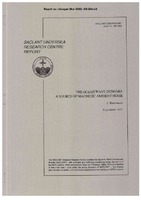| dc.contributor.author | Watermann, Jürgen | |
| dc.date.accessioned | 2018-10-11T14:08:37Z | |
| dc.date.available | 2018-10-11T14:08:37Z | |
| dc.date.issued | 1997/09 | |
| dc.identifier | 11883 | |
| dc.identifier.govdoc | SR-264 | |
| dc.identifier.uri | http://hdl.handle.net/20.500.12489/489 | |
| dc.description.abstract | The electromagnetic dynamo field of sea surface waves, a consequence of the Lorentz force, has been measured with two simultaneously operating, closely spaced tri-axial magnetometers. Measurements from a magnetometer located in the centre of a small, uninhabited island served to compensate measurements from a near-shore magnetometer for large-scale magnetic pulsations (basically of ionospheric origin), leaving the ocean wave dynamo field, effective close to shore only, as the dominant residual magnetic field. Height and period of waves and swell were recorded with a vertical accelerometer (wave rider buoy) floating nearby on the sea surface. Amplitude and phase relationships between the three vector components of the magnetic field differences yield an ocean wave vector consistent with swell propagating northeastward. The magnetic field data further demonstrate that the water mass motion close to shore was not confined to a vertical plane (as would be the case for freely propagating gravity waves in the open ocean). The motion occurred in a plane inclined at about 40° from the horizontal (roughly twice the inclination of the island flanks). Ten nighttime intervals of three hours each were analysed, and for every interval, the peak power of the | |
| dc.description.abstract | surface waves (inferred from the wave rider measurements) was compared with the peak power of | |
| dc.description.abstract | the residual horizontal magnetic field (after the background field had been removed). Their ratio yields | |
| dc.description.abstract | the height of a hypothetical magnetometer above the surface of the open sea. Not only are the hypothetical heights computed for the ten different intervals similar, they are also approximately equal to the horizontal distance between the shoreline and the site of the near-shore magnetometer. Our results suggest that the island-based dual-sensor magnetic field observations yield, within the limits of statistical significance, a reproducible quantitative description of the amplitude and frequency of sea surface waves and swell, and of the mean water mass motion within about one wavelength from shore. Our results further suggest that the surface wave dynamo field is in quantitative agreement with predictions from classical theory. We can not confirm reports in the technical literature about an allegedly excessively intense ocean wave dynamo field. | |
| dc.format | 33 p. : ill. ; 10 fig. | |
| dc.language | English | |
| dc.publisher | NATO. SACLANTCEN | |
| dc.relation.ispartofseries | ADA344644 | |
| dc.subject | Magnetic ambient noise | |
| dc.subject | Surface waves | |
| dc.title | The ocean wave dynamo: a source of magnetic ambient noise | |
| dc.type | Scientific Report (SR) | |
